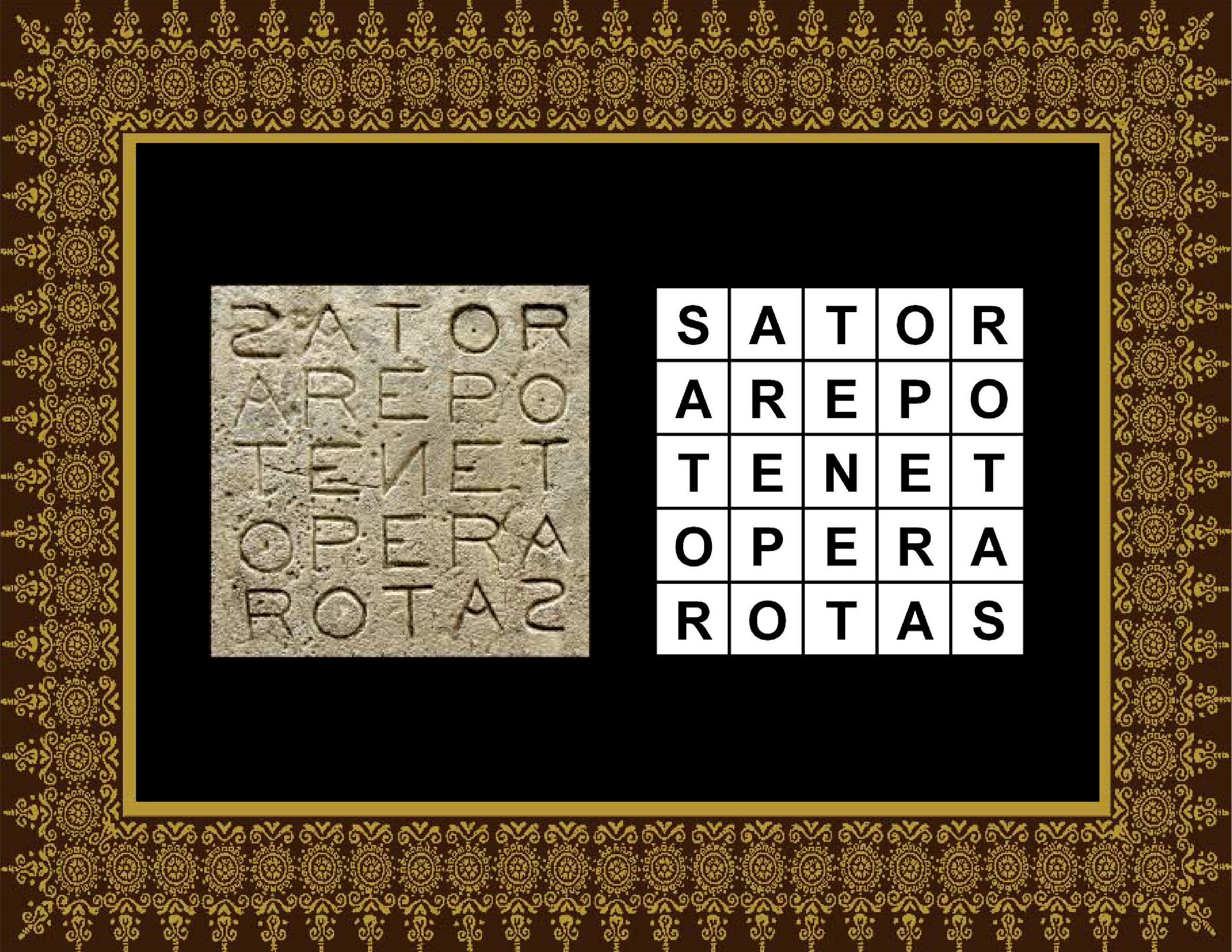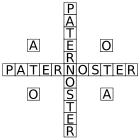 Submitted by Talisman on
Submitted by Talisman on

derivativeimages
The Sator Square, ancestor of crosswords, is a famous word square in Latin. It is a word square containing a Latin palindrome featuring the words SATOR AREPO TENET OPERA ROTAS written in a square so that they may be read top-to-bottom, bottom-to-top, left-to-right, and right-to-left. Note that a word square is a special case of acrostic. It consists of a set of words, all having the same number of letters as the total number of words (the "order" of the square); when the words are written out in a square grid horizontally, the same set of words can be read vertically. So, the Sator square is a kind of crossword puzzle, rather than a mathematical magic square. The earliest known appearance of the Sator Square was found in the ruins of Herculaneum (an ancient Roman town) which was buried in the ash of Mt. Vesuvius in 79 AD. Therefore, its origins may well predate the Christian era.
The Sator Square also forms a sentence, though its meaning is obscure. Possible translations of the phrase are 'The sower Arepo holds the wheels with effort' or 'The sower Arepo leads with his hand (work) the plough (wheels).' and 'The Great Sower holds in his hand all works; all works the Great Sower holds in his hand.' (Ceram 1958, p. 30). The word arepo is enigmatic, appearing nowhere else in Latin literature. Most of those who have studied the Sator Square agree that it is a proper name, either an adaptation of a non-Latin word or most likely a name invented specifically for this sentence.
As pointed by F. Grosser, it is possible to write a horizontal and a vertical 'Pater Noster' (the Our Father Prayer) with the letters of the sator square, forming a Greek cross. Its composition is amazing complexity: we see that the word tenet forms a cross with four branches that are closed with the letter T (whose form itself refers to the cross) surrounded by the letters A (Greek alpha) and O (Greek omega) that evoke Jesus Christ designated as the Alpha and the Omega, ie the origin and purpose of all things. In addition, one can, with the 25 letters of the square, form a cross writing Pater Noster completed by two A and two O, holders of the above symbolic (see illustration). In Rome, we find these two designs carved on the walls and on the graves of the early Christian shrines.
The result is striking. The perfect symmetry of all the letters around the central N skips first to eyes. There is also the "fish", symbolized by the central letter N, this N, or 'noun' meaning fish in Aramaic; the fish in Greek is said ΙΧΘΥΣ (ikhthus or Ichthys), acrostic of the declaration of faith: I : ΙΗΣΟΥΣ (Iēsous), X : ΧΡΙΣΤΟΣ (Khristos), Θ : ΘΕΟΥ (Théou) Υ : ΥΙΟΣ (Uios), Σ : ΣΩΤΗΡ (Sōtēr). We can summarize this by "Jesus Christ the Savior and the son of G

The Sator-Rotas Square (or Templar Magic Square), with the embedded anagram of Pater Noster, is an ancient charm of great power and mystery. The earliest example was discovered scratched on a wall in the buried city of Pompeii and dated back to the first century AD. Although used by early Christian Mystics as a magical charm the square has surfaced in cultures and religions all over the world. Because of the hidden anagram, Pater Noster, the square was originally thought to be of Christian design, but there is now strong evidence that it predates Christianity by a considerable margin and refers to the ancient God, Mithras.
In Rome during the Middle Ages this square was inscribed on a variety of common, everyday objects such as utensils and drinking vessels. It was also found above doorways. It was believed that the square had magical properties, and that making it visible would ward off evil spirits. The words on this square roughly translate to "The Creator (or Savior) holds the working of the spheres in his hands." C. W. Ceram read the square boustrophedon (in alternating directions), with tenet repeated. This produces Sator opera tenet; tenet opera sator, translated: 'The Great Sower holds in his hand all works; all works the Great Sower holds in his hand.' (Ceram 1958, p. 30)
The Sator-Rotas Square has been discovered in many countries and from many periods of history. The example here was found in 1925 on the bathroom wall of Paquius Proculus. It appeared to have been scratched there in 79 a.d. The Square was carried by the Roman Legions and was used throughout the Roman Empire.
It was also found in Egypt dating from the fourth or fifth century where it was written on papyri or parchment and carried as an amulet. Later, in the ninth century it was used in cave paintings in Cappadocia.
Using numerology (mystical or esoteric relationship between numbers), one can assign the value 1 to the letter A, 2 to the letter B, and so on, up to 26 for the letter Z. Then, adding the values assigned to the letters in the rows and columns of the Sator square yields the following:
S A T O R ⇒ S + A + T + O + R = 19 + 1 + 20 + 15 + 18 = 73 ⇒ 7 + 3 = 10 ⇒ 1
A R E P O ⇒ A + R + E + P + O = 1 + 18 + 5 + 16 + 15 = 55 ⇒ 5 + 5 = 10 ⇒ 1
T E N E T ⇒ T + E + N + E + T = 20 + 5 + 14 + 5 + 20 = 64 ⇒ 6 + 4 = 10 ⇒ 1
O P E R A ⇒ O + P + E + R + A = 15 + 16 + 5 + 18 + 1 = 55 ⇒ 5 + 5 = 10 ⇒ 1
R O T A S ⇒ R + O + T + A + S = 18 + 15 + 20 + 1 + 19 = 73 ⇒ 7 + 3 = 10 ⇒ 1
Each of these values digit sum to 10 and therefore also to 1, which some numerologists maintain gives the square "extraordinary powers".
Read more @ http://www.taliscope.com/Sator_en.html